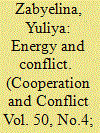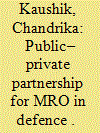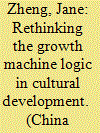| Srl | Item |
| 1 |
ID:
142068


|
|
|
|
|
| Summary/Abstract |
Attacks on oil and gas infrastructures by terrorists and criminals in places like Nigeria, Colombia, Iraq and Russia have amplified the vulnerability of critical energy infrastructures (CEIs) to deliberate physical attacks. Being unable or unwilling to protect CEIs, many national governments have made attempts to alleviate these vulnerabilities through outsourcing of security, i.e. contracting the responsibility to protect CEIs out to non-state actors. This article advocates the need to conceptualize security outsourcing in the domain of critical energy infrastructure protection (CEIP) in order to explain a variety of regulatory choices made by governments in this domain. Based on a qualitative analysis of four case studies, the article discusses various types of security outsourcing in the protection of CEIs, including the militarization of national oil companies, public–private partnerships and the involvement of international organizations and local social groups. The typology may serve as a tool of describing, classifying and evaluating various forms of security outsourcing. The findings of the article help to deconstruct the complexity of security outsourcing and capture some of the major contemporary trends in energy security.
|
|
|
|
|
|
|
|
|
|
|
|
|
|
|
|
| 2 |
ID:
154403


|
|
|
|
|
| Summary/Abstract |
This article examines the various aspects of employing public–private partnership (PPP) for carrying out maintenance, repair and overhaul (MRO) activities for aerospace and land forces in India. PPP in MRO is expected to increase the uptime of the existing equipment, and enable their full exploitation. It would enable harnessing the efficiencies of the private sector while using the resources existing in the public sector. The broad concepts and operational philosophy of MRO for defence equipment are also covered. The enabling mechanisms implemented by the United States (US) for fostering PPP in MRO are discussed as a case study. The article seeks to build up a case for exploring possible exploitation of PPP for MRO in the Indian defence sector, for learning how to leverage the potential of the private sector and the facilities available in the public sector, while retaining overall control by the government.
|
|
|
|
|
|
|
|
|
|
|
|
|
|
|
|
| 3 |
ID:
189972


|
|
|
|
|
| Summary/Abstract |
Using urban sculpture planning in Shanghai as a case study, this article aims to understand the process of planning cultural projects in China and to evaluate the applicability of the growth machine model to the social dynamics underlying cultural development in Chinese cities. Based on interviews with sculpture planning officers in 10 districts and the municipality, as well as 56 companies that have been involved in sculpture projects in Shanghai, this article argues that the growth machine model is of limited applicability to urban sculpture planning in Shanghai. Instead, a public-sector-centred tripartite model is more applicable for the following reasons. First, most cooperative relationships in key cultural development projects engage state-patronized public corporations instead of the private sector. Here the government plays a dominant role. Second, public–private partnership is rare and loosely formed. The broadly defined concept of shared cultural capital that includes personal artistic tastes, altruistic motivations, and brand building concerns engenders public–private cooperation. Third, the local state adopts a laissez-faire approach to most of the private-sector-invested cultural projects that the government considers to be less crucial to its vision for Shanghai’s art landscape.
|
|
|
|
|
|
|
|
|
|
|
|
|
|
|
|